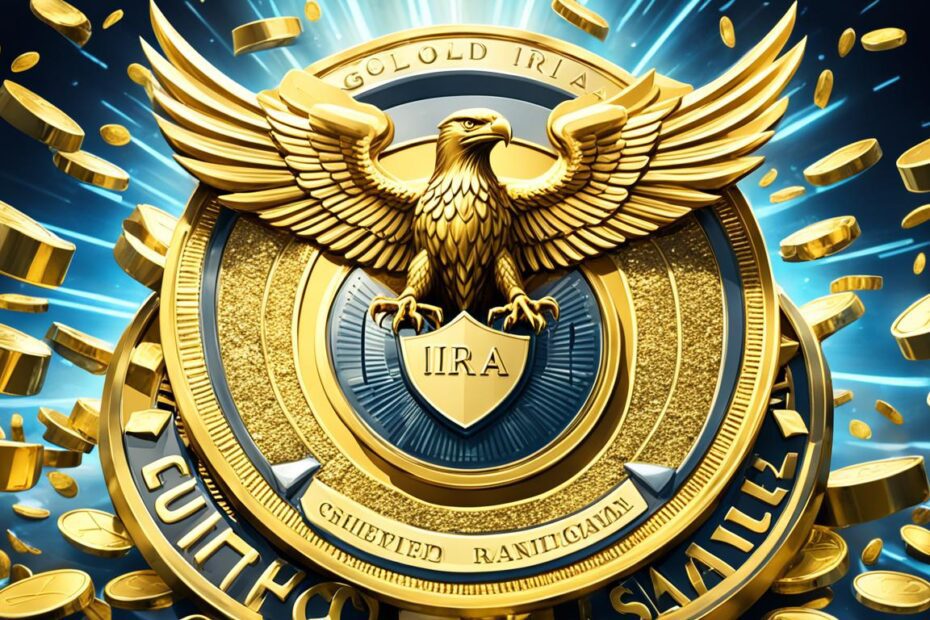Are you looking for a retirement investment that offers more than just stocks and bonds? Have you considered the potential benefits of a gold IRA? While traditional retirement accounts are typically limited to more conventional assets, a gold IRA provides the opportunity to diversify your portfolio with precious metals. But what exactly are the benefits of a gold IRA, and how can it help secure your financial future? Let’s explore the advantages of this unique retirement investment and discover why it might be the perfect addition to your retirement strategy.
Key Takeaways:
- Diversify your retirement portfolio with a gold IRA
- Enjoy potential tax benefits by investing in precious metals
- Hold physical gold or precious metals-related securities in a specialized IRA
- Find a specialty custodian or firm to set up and manage your gold IRA
- Consider the risks and consult with a financial advisor before making any investment decisions
Understanding Gold IRAs
Gold IRAs offer investors the opportunity to include physical gold and other precious metals in their retirement accounts. Also known as precious metals IRAs, these accounts are distinct from traditional IRAs and provide individuals with a unique way to diversify their retirement portfolios.
The Internal Revenue Service (IRS) permits self-directed IRA holders to invest in gold, silver, platinum, or palladium bars, coins, or other approved physical forms. This allows investors to take advantage of the inherent value and stability of precious metals as retirement assets.
To open a gold IRA, investors must work with a specialized custodian or firm. These custodians are responsible for handling the necessary documentation and reporting, ensuring compliance with IRS regulations for retirement accounts. Working with a custodian is essential as it allows investors to securely manage their physical gold or precious metals.
By including physical gold and precious metals in their retirement accounts, investors can potentially protect their portfolios against market volatility and economic uncertainties. These tangible assets provide a potential safeguard against inflation and preserve wealth over the long term.
With a gold IRA, investors have the flexibility to allocate a portion of their retirement savings to physical assets that have historically retained value. This diversification strategy helps reduce the overall risk in a retirement portfolio and may offer a level of stability that complements more traditionally invested funds.
Investing in a gold IRA requires careful consideration and research. It is recommended to consult with a financial advisor who specializes in retirement planning to determine if a gold IRA aligns with your long-term financial goals and risk tolerance.
Overall, a gold IRA provides a unique opportunity to include physical gold and precious metals in a retirement account, enhancing diversification and potentially mitigating risk. By working with a specialized custodian, investors can navigate the complexities of investing in physical gold within the framework of retirement accounts.
Setting Up a Gold IRA
When it comes to setting up a gold IRA, traditional custodians like conventional brokers do not offer this specialty account option. Instead, investors must seek out a specialized custodian or firm that can handle the necessary documentation and reporting for tax purposes. This ensures compliance with the specific regulations surrounding gold IRAs.
One important consideration when setting up a gold IRA is understanding the contribution limits. The contribution limits for a gold IRA are the same as those for traditional IRAs, as set by the IRS. It’s crucial to stay within these limits to avoid any penalties or tax implications.
Additionally, distributions from a gold IRA can be made without penalties after reaching the age of 59½, similar to traditional IRAs. This allows investors to access their savings in retirement without facing any financial penalties.
Furthermore, storage is a crucial aspect of holding physical gold within a gold IRA. The IRS requires that physical gold be stored in an approved facility. This ensures the security and authenticity of the assets held within the account.
Gold IRA Storage Regulations
As mentioned earlier, the storage of physical gold within a gold IRA must be done at an IRS-approved facility. These storage facilities are equipped with advanced security measures, providing peace of mind for investors. By adhering to these stringent storage regulations, the integrity and value of the gold holdings are protected.
| Benefits of IRS-Approved Storage: |
Drawbacks of Unapproved Storage: |
|---|---|
|
|
By utilizing an IRS-approved storage facility, investors can ensure the safety and proper storage of their physical gold holdings, reducing the risk of loss or damage.
When considering setting up a gold IRA, it’s crucial to partner with a custodian or firm well-versed in the requirements and regulations. They can guide investors through the necessary steps and paperwork, ensuring a seamless and compliant process. With the right setup, individuals can enjoy the benefits that a gold IRA offers for their retirement savings.
Types of Gold IRAs

When it comes to investing in gold IRAs, there are different options available for investors to consider. Each type of gold IRA comes with its own set of advantages and considerations. Let’s explore the various types:
1. Traditional Gold IRAs
Traditional gold IRAs are funded with pretax dollars. This means that contributions made to a traditional gold IRA may be tax-deductible, providing potential tax benefits. However, taxes will be owed upon withdrawal during retirement.
2. Roth Gold IRAs
Roth gold IRAs, on the other hand, are funded with after-tax money. While contributions to a Roth gold IRA are not tax-deductible, qualified withdrawals during retirement are generally tax-free.
3. SEP Gold IRAs
SEP gold IRAs are specifically designed for employees of small businesses or self-employed individuals. These IRAs allow for higher contribution limits compared to traditional and Roth IRAs, providing an opportunity for enhanced retirement savings.
4. Contribution Limits
Contribution limits for gold IRAs are set by the IRS and can vary depending on the type of IRA. Individuals can set aside a certain percentage of their compensation or a specific dollar amount, whichever is lower, for their gold IRA contribution. It’s important to note that these contribution limits can change annually, so it’s crucial for investors to stay updated on the latest IRS guidelines.
By understanding the different types of gold IRAs and their associated contribution limits, investors can make informed decisions about their retirement savings strategy. It’s always beneficial to consult with a financial advisor who can provide personalized guidance based on individual financial goals and circumstances.
Risks of Gold IRAs

Investing in gold IRAs involves certain risks that should be taken into consideration. While holding gold can offer benefits, such as acting as a hedge against inflation and diversifying a portfolio, there are factors that can affect its value and performance.
Gold itself does not generate dividends or earnings like stocks or other investments. Its value is influenced by market volatility, which means that the price of gold can fluctuate over time. This volatility can lead to uncertainty in returns compared to more traditional investments.
During periods of economic stability, when the stock market is performing well, a gold IRA may not provide the same level of returns. Stocks have historically outperformed gold over long periods, which means that the growth potential of a gold IRA may not be as high.
However, it’s important to note that gold is often seen as a safe haven during times of economic uncertainty or market turbulence. Its value can rise when there is a decline in the stock market or fluctuations in currency values. This can make gold an attractive option for diversifying a portfolio and potentially minimizing losses during turbulent times.
The Relationship Between Gold and Market Volatility
Gold has a long history of being viewed as a store of value and a safe investment during times of market volatility. When investors are concerned about the stability of other assets, such as stocks or currencies, they often turn to gold as a way to preserve their wealth.
However, it’s important to remember that gold is not immune to market fluctuations. While it may have a lower correlation with other assets, it can still be affected by changes in investor sentiment, economic indicators, and geopolitical events.
It’s also worth noting that gold prices can be influenced by factors such as supply and demand dynamics, changes in mining production, and central bank policies regarding gold reserves. These factors can impact the value and performance of gold, and by extension, gold IRAs.
Despite the risks, many investors choose to include gold IRAs in their overall investment strategy. By carefully considering the potential benefits and risks, and consulting with a financial advisor, investors can make informed decisions about whether a gold IRA aligns with their investment goals and risk tolerance.
Performance Comparison: Gold IRA vs. Traditional Investments
| Investment | Annual Return (%) | Average 10-Year Return (%) |
|---|---|---|
| Gold IRA | 5.2 | 4.7 |
| Stocks | 8.7 | 9.2 |
| Bonds | 3.2 | 3.5 |
Are Gold IRAs a Good Idea?
When considering investment strategies for retirement assets, diversification is key. Gold IRAs can be a valuable addition to your portfolio, offering potential benefits and acting as a hedge against certain financial factors.
By including gold IRAs in your investment strategy, you can enhance diversification within your retirement portfolio. The inclusion of gold provides an additional asset class that may perform differently from traditional investments like stocks and bonds.
Gold has historically shown resilience in times of economic uncertainty, making it a popular choice for investors looking to protect their wealth. It can act as a safeguard against inflation, as its value may increase during periods of economic instability.
While gold IRAs can offer stability and diversification, it is important to approach them as a small portion of your overall retirement assets. We recommend consulting with a financial advisor to determine the appropriate allocation based on your individual financial goals and risk tolerance.
Remember, diversifying your retirement assets is crucial for long-term financial security. By including a small portion of gold IRAs in your investment portfolio, you can take advantage of its potential benefits while maintaining a balanced and diversified retirement strategy.
| Investment | Benefits | Risks |
|---|---|---|
| Gold IRAs |
|
|
| Traditional Investments |
|
|
How Much Can You Put in a Gold IRA?
When considering a gold IRA as part of your retirement investment strategy, it’s important to understand the contribution limits set by the IRS. These contribution limits apply to both traditional IRAs and Roth IRAs, ensuring fairness and consistency in retirement savings. Let’s take a closer look at the current contribution limits for a gold IRA.
Contribution Limits for 2023 and 2024
In 2023, the contribution limit for a gold IRA is $6,500. This means that individuals can contribute up to this amount to their gold IRA account. But the good news is that the contribution limit is increasing to $7,000 in 2024, allowing for even greater retirement savings potential.
If you’re 50 years old or older, you have the opportunity to make additional catch-up contributions. For both 2023 and 2024, individuals in this age group can contribute an extra $1,000, increasing their overall contribution power and maximizing their long-term retirement savings.
It’s essential to keep these contribution limits in mind when planning your gold IRA investment strategy. By staying within the allocated contribution limits, you can make the most of this retirement investment option while enjoying potential tax advantages and the stability that comes with diversifying your portfolio.
| Year | Contribution Limit | Catch-Up Contribution (50+) |
|---|---|---|
| 2023 | $6,500 | $1,000 |
| 2024 | $7,000 | $1,000 |
This table provides a clear breakdown of the contribution limits for both traditional IRAs and Roth IRAs for the years 2023 and 2024. It serves as a useful reference point when considering your investment options and planning for a secure and comfortable retirement.
With a strong understanding of the contribution limits for a gold IRA, you can confidently move forward with your retirement planning. By making informed decisions and staying within these limits, you can effectively grow your savings and work towards a financially stable future.
Conclusion
Opening a gold IRA can provide numerous benefits for retirement planning. By incorporating a gold IRA into your retirement strategy, you can diversify your assets and mitigate risk. Holding physical gold or other precious metals within a gold IRA offers a tangible and secure investment option.
One of the key advantages of a gold IRA is the potential tax benefits it offers. With careful planning and guidance from a financial advisor, you can maximize these advantages and optimize your retirement savings.
It’s important to note that like any investment, gold IRAs come with risks. The value of gold can fluctuate with market volatility, and it may not perform as well as other traditional investments during periods of economic stability. Therefore, it’s crucial to seek professional advice and consider your risk tolerance before making any investment decisions.
Overall, incorporating a gold IRA into your retirement strategy can be a smart move. It allows you to diversify your portfolio, take advantage of potential tax benefits, and protect against economic uncertainty. Consider the benefits and risks, consult with a financial advisor, and make an informed decision that aligns with your long-term retirement goals.
